check engine SKODA SUPERB 2008 2.G / (B6/3T) Owner's Guide
[x] Cancel search | Manufacturer: SKODA, Model Year: 2008, Model line: SUPERB, Model: SKODA SUPERB 2008 2.G / (B6/3T)Pages: 272, PDF Size: 18.25 MB
Page 210 of 272
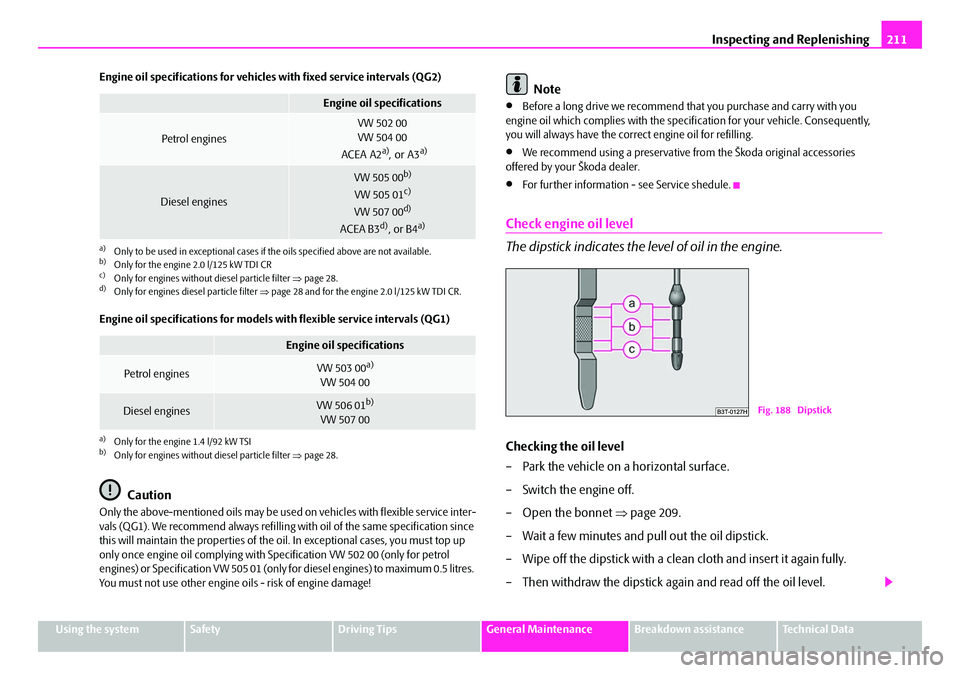
Inspecting and Replenishing211
Using the systemSafetyDriving TipsGeneral MaintenanceBreakdown assistanceTechnical Data
Engine oil specifications for vehicles with fixed service intervals (QG2)
Engine oil specifications for models with flexible service intervals (QG1)
Caution
Only the above-mentioned oils
may be used on vehicles with flexible service inter-
vals (QG1). We recommend always refilling with oil of the same specification since
this will maintain the properties of the oil. In exceptional cases, you must top up
only once engine oil complying with Sp ecification VW 502 00 (only for petrol
engines) or Specification VW 505 01 (only for diesel engines) to maximum 0.5 litres.
You must not use other engine oi ls - risk of engine damage!
Note
•Before a long drive we recommend th at you purchase and carry with you
engine oil which complies with the specif ication for your vehicle. Consequently,
you will always have the correct engine oil for refilling.
•We recommend using a preservative from the Škoda original accessories
offered by your Škoda dealer.
•For further information - see Service shedule.
Check engine oil level
The dipstick indicates the le vel of oil in the engine.
Checking the oil level
– Park the vehicle on a horizontal surface.
– Switch the engine off.
– Open the bonnet ⇒page 209.
– Wait a few minutes and pull out the oil dipstick.
– Wipe off the dipstick with a clean cloth and insert it again fully.
– Then withdraw the dipstick again and read off the oil level.
Engine oil specifications
Petrol engines
VW 502 00
VW 504 00
ACEA A2
a), or A3a)
a)Only to be used in exceptional cases if the oils specified above are not available.
Diesel engines
VW 505 00b)
VW 505 01c)
VW 507 00d)
ACEA B3d), or B4a)
b)Only for the engine 2.0 l/125 kW TDI CRc)Only for engines without diesel particle filter ⇒page 28.d)Only for engines diesel particle filter ⇒page 28 and for the engine 2.0 l/125 kW TDI CR.
Engine oil specifications
Petrol enginesVW 503 00a)
VW 504 00
a)Only for the engine 1.4 l/92 kW TSI
Diesel enginesVW 506 01b)
VW 507 00
b)Only for engines without diesel particle filter ⇒page 28.
Fig. 188 Dipstick
NKO B6 20.book Page 211 Wednesday, March 26, 2008 3:15 PM
Page 211 of 272
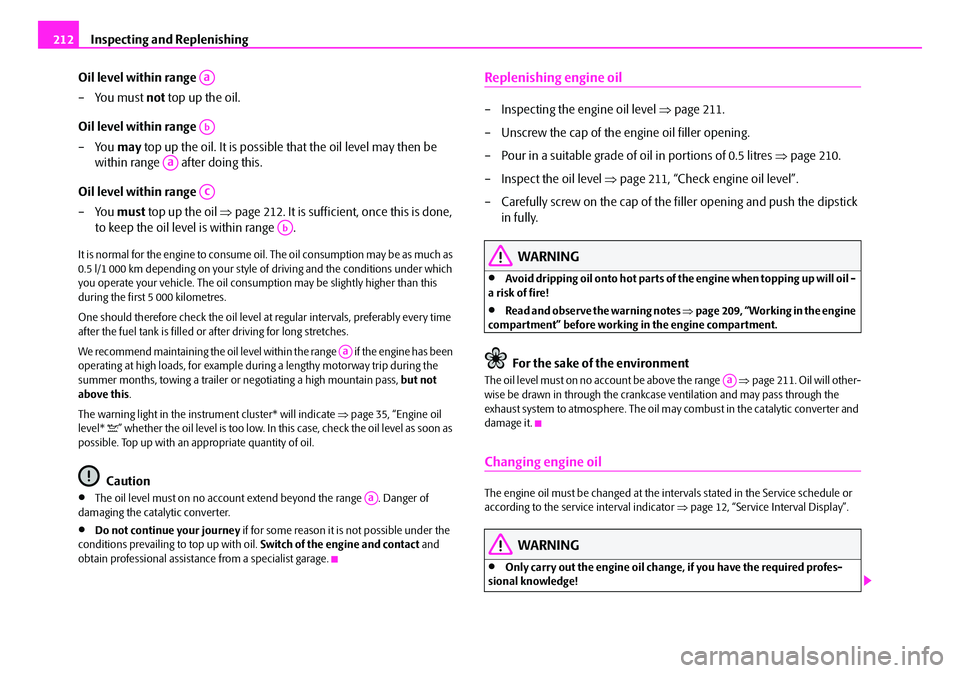
Inspecting and Replenishing
212
Oil level within range
–You must not top up the oil.
Oil level within range
–You may top up the oil. It is possible that the oil level may then be
within range after doing this.
Oil level within range
–You must top up the oil ⇒page 212. It is sufficient, once this is done,
to keep the oil level is within range .
It is normal for the engine to consume oil. The oil cons umption may be as much as
0.5 l/1 000 km depending on your style of driving and the conditions under which
you operate your vehicle. The oil consumpt ion may be slightly higher than this
during the first 5 000 kilometres.
One should therefore check the oil level at regular intervals, preferably every time
after the fuel tank is filled or after driving for long stretches.
We recommend maintaining the oil level within the range if the engine has been
operating at high loads, for example during a lengthy motorway trip during the
summer months, towing a trailer or negotiating a high mountain pass, but not
above this .
The warning light in the instrument cluster* will indicate ⇒page 35, “Engine oil
level* ” whether the oil level is too low. In this case, check the oil level as soon as
possible. Top up with an a ppropriate quantity of oil.
Caution
•The oil level must on no account ex tend beyond the range . Danger of
damaging the catalytic converter.
•Do not continue your journey if for some reason it is not possible under the
conditions prevailing to top up with oil. Switch of the engine and contact and
obtain professional assistance from a specialist garage.
Replenishing engine oil
– Inspecting the engine oil level ⇒page 211.
– Unscrew the cap of the engine oil filler opening.
– Pour in a suitable grade of oil in portions of 0.5 litres ⇒page 210.
– Inspect the oil level ⇒page 211, “Check engine oil level”.
– Carefully screw on the cap of the filler opening and push the dipstick in fully.
WARNING
•Avoid dripping oil onto hot parts of the engine when topping up will oil -
a risk of fire!
•Read and observe the warning notes ⇒page 209, “Working in the engine
compartment” before working in the engine compartment.
For the sake of the environment
The oil level must on no account be above the range ⇒page 211. Oil will other-
wise be drawn in through the crankcase ventilation and may pass through the
exhaust system to atmosphere. The oil ma y combust in the catalytic converter and
damage it.
Changing engine oil
The engine oil must be changed at the intervals stated in the Service schedule or
according to the service interval indicator ⇒page 12, “Service Interval Display”.
WARNING
•Only carry out the engine oil change, if you have the required profes-
sional knowledge!
Aa
Ab
Aa
Ac
Ab
Aa
Aa
Aa
NKO B6 20.book Page 212 Wednesday, March 26, 2008 3:15 PM
Page 213 of 272
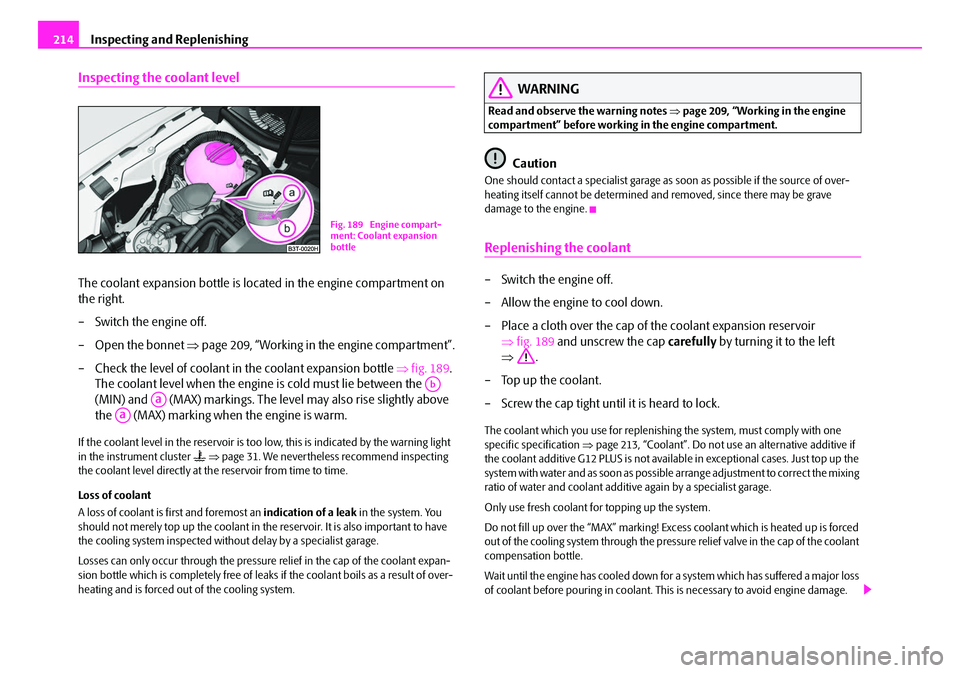
Inspecting and Replenishing
214
Inspecting the coolant level
The coolant expansion bottle is loca ted in the engine compartment on
the right.
– Switch the engine off.
– Open the bonnet ⇒page 209, “Working in the engine compartment”.
– Check the level of coolant in the coolant expansion bottle ⇒fig. 189 .
The coolant level when the engine is cold must lie between the
(MIN) and (MAX) markings. The level may also rise slightly above
the (MAX) marking when the engine is warm.
If the coolant level in the reservoir is too low, this is indicated by the warning light
in the instrument cluster ⇒ page 31. We nevertheless recommend inspecting
the coolant level directly at th e reservoir from time to time.
Loss of coolant
A loss of coolant is first and foremost an indication of a leak in the system. You
should not merely top up the coolant in the reservoir. It is also important to have
the cooling system inspected without delay by a specialist garage.
Losses can only occur through the pressure relief in the cap of the coolant expan-
sion bottle which is completely free of leak s if the coolant boils as a result of over-
heating and is forced out of the cooling system.
WARNING
Read and observe the warning notes ⇒page 209, “Working in the engine
compartment” before working in the engine compartment.
Caution
One should contact a specialist garage as soon as possible if the source of over-
heating itself cannot be determined and removed, since there may be grave
damage to the engine.
Replenishing the coolant
– Switch the engine off.
– Allow the engine to cool down.
– Place a cloth over the cap of the coolant expansion reservoir ⇒fig. 189 and unscrew the cap carefully by turning it to the left
⇒ .
– Top up the coolant.
– Screw the cap tight until it is heard to lock.
The coolant which you use for replenishing the system, must comply with one
specific specification ⇒page 213, “Coolant”. Do not use an alternative additive if
the coolant additive G12 PLUS is not available in exceptional cases. Just top up the
system with water and as soon as possible arrange adjustment to correct the mixing
ratio of water and coolant additive again by a specialist garage.
Only use fresh coolant for topping up the system.
Do not fill up over the “MAX” marking! Excess coolant which is heated up is forced
out of the cooling system through the pressure relief valve in the cap of the coolant
compensation bottle.
Wait until the engine has cooled down for a system which has suffered a major loss
of coolant before pouring in coolant. This is necessary to avoid engine damage.
Fig. 189 Engine compart-
ment: Coolant expansion
bottle
Ab
Aa
Aa
NKO B6 20.book Page 214 Wednesday, March 26, 2008 3:15 PM
Page 218 of 272

Inspecting and Replenishing219
Using the systemSafetyDriving TipsGeneral MaintenanceBreakdown assistanceTechnical Data
Inspecting the electrolyte level
The battery is practically maintenance-free under normal oper ating conditions.
We do, however, recommend that you have the electrolyte level inspected from
time to time by a Škoda Service Partner when outside temperatures are high or
when driving on long trips. You shou ld also check the electrolyte level ⇒page 219
each time the battery is charged.
The battery acid level will also be chec ked as part of the Inspection Service.
Operation in winter
The battery has to provide greater amounts of electricity during the winter. It also
has only part of the initial power output at low temperatures that it has at normal
temperatures.
A discharged battery may already freez e at temperatures just below 0°C.
We therefore recommend that you have the battery checked by a Škoda dealer
before the start of the winter, and recharged if necessary.
WARNING
Never charge a frozen or thawed battery - risk of explosion and caustic
burns. Replace a frozen battery.
Charging the battery
A properly charged battery is essential for reliably starting the
engine.
–Read the warning notes ⇒ in “Working on the battery” on
page 216 and ⇒.
– Switch the ignition and all electrical components off.
– Only for “quick-charging”: Disconnect both battery cables (first of all
“negative”, then “positive”). – Carefully attach the terminal clamps of the charger to the battery
terminals (red = “positive”, black = “negative”).
– You can now plug the mains cable of the charger into the power socket
and switch on the charger.
– When charging is completed: switch the charger off and unplug the mains cable from the power socket.
– Only then should you disconnect the terminal clamps of the charger.
– Reconnect the cables to the battery (first of all “positive”, then “nega- tive”).
It is not normally necessary to disconnect the cables of the battery if you recharge
the battery using low amperages (as for example from a mini-charger). Please also
refer to the instructions from the charger manufacturer.
A charging current of 0.1 of the total battery capacity (or lower) is that which should
be used until full charging is achieved.
It is, however, necess ary to disconnect both cables be fore charging the battery with
high amperages, so-called “ quick-charging”.
“Quick-charging” a battery is dangerous ⇒ in “Working on the battery” on
page 216. It requires a special charger an d appropriate knowledge. We therefore
recommend that you have your battery qu ick-charged only by your Škoda Service
Par tner.
A discharged battery may already freeze at temperatures just below 0°C ⇒. We
recommend that you no longer use a ba ttery which has thawed out because the
casing of the battery may be cracked through the formation of ice and this would
allow battery electrolyte to flow out.
The vent plugs of the battery should not be opened for charging.
WARNING
Never charge a frozen or thawed battery - risk of explosion and caustic
burns. Replace a frozen battery.
NKO B6 20.book Page 219 Wednesday, March 26, 2008 3:15 PM
Page 219 of 272

Inspecting and Replenishing
220
Disconnecting and reconnecting the battery
On disconnecting and reconnecting the battery the following functions are initially
deactivated or are no longer able to operate fault-free.
We recommend having the vehicle checked by a Škoda Service Partner to ensure
full functionality of all electrical systems.
Replacing the battery
You should only replace a battery with a new battery of the same capacity, voltage
(12 V), amperage and of the same size. Škoda Service Partners have a range of suit-
able batteries available.
We recommend that you only have an old battery disposed of by your Škoda dealer
since it does require special disposal.
For the sake of the environment
Batteries contain poisonous substances such as sulphuric acid and lead. They must
be disposed of in accordance with local environmental protection regulations and
on no account as domestic waste.
Windshield washer system
The windshield washer reserv oir contains the cleaning fluid for the windscreen or
rear window and for the headlamp cleaning system*. The reservoir is located at the
front right of the engine compartment ⇒fig. 194 .
The filling level of the container is 3 litres, 5.5 li tres on vehicles which also have a
headlight washing system.
Clear water is not sufficient to intensivel y clean the windscreen and headlights. We
therefore recommend using clean washing water together with the screen cleaner
from Škoda genuine accessorie s (in winter additionally with antifreeze) which is
capable of removing stubborn dirt. Follow the instructions for use on the packaging
when using screen cleaning products.
You should always add antifreeze to the cleaning water in winter even if your
vehicle is fitted with heated windscreen washer nozzles*.
It is also possible in exceptional cases to use methylated spirits when no screen
cleaner with antifreeze is available. The concentration of methylated spirits must
not be more than 15 %. Please note, however, that the antifreeze protection at this
concentration is only adequate down to -5°C.
WARNING
Read and observe the warning notes ⇒page 209, “Working in the engine
compartment” before working in the engine compartment.
OperationOperating measure
Electrical power window (operational faults)⇒ page 49
Enter radio code numbersee Radio Operating Instructions
Set hours⇒page 14
Data in the multi-functional indicator* are
deleted.⇒page 14Fig. 194 Engine compart-
ment: Windshield washer
fluid reservoir
NKO B6 20.book Page 220 Wednesday, March 26, 2008 3:15 PM
Page 231 of 272
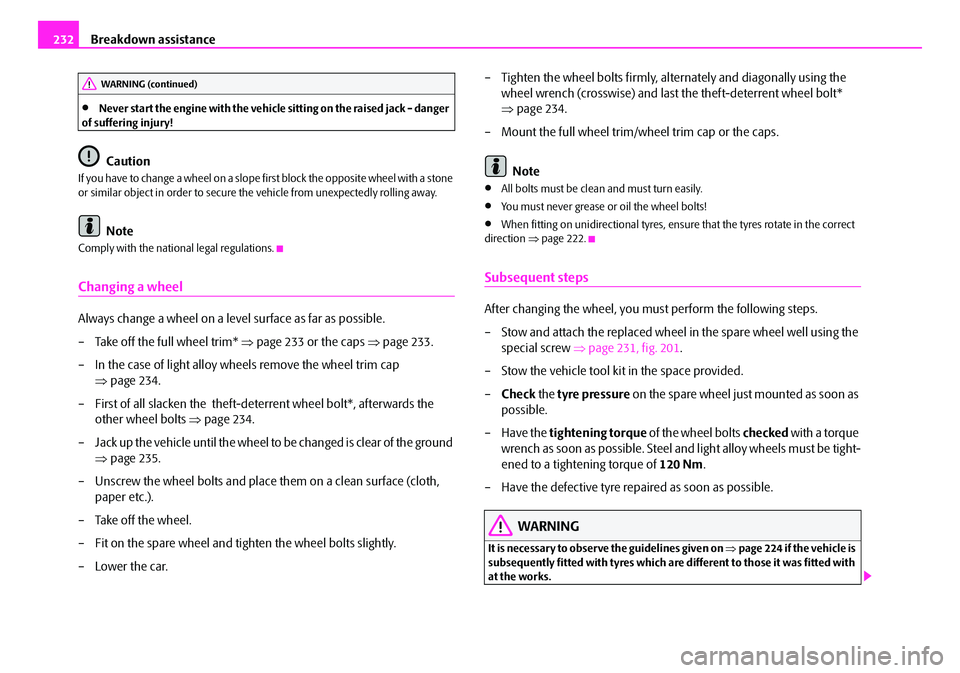
Breakdown assistance
232
•Never start the engine with the vehicle sitting on the raised jack - danger
of suffering injury!
Caution
If you have to change a wheel on a slope first block the opposite wheel with a stone
or similar object in order to secure th e vehicle from unexpectedly rolling away.
Note
Comply with the national legal regulations.
Changing a wheel
Always change a wheel on a level surface as far as possible.
– Take off the full wheel trim* ⇒page 233 or the caps ⇒page 233.
– In the case of light alloy wheels remove the wheel trim cap ⇒page 234.
– First of all slacken the theft-de terrent wheel bolt*, afterwards the
other wheel bolts ⇒page 234.
– Jack up the vehicle until the wheel to be changed is clear of the ground
⇒ page 235.
– Unscrew the wheel bolts and place them on a clean surface (cloth, paper etc.).
– Take off the wheel.
– Fit on the spare wheel and tighten the wheel bolts slightly.
–Lower the car. – Tighten the wheel bolts firmly, al
ternately and diagonally using the
wheel wrench (crosswise) and last the theft-deterrent wheel bolt*
⇒ page 234.
– Mount the full wheel trim/w heel trim cap or the caps.
Note
•All bolts must be clean and must turn easily.
•You must never grease or oil the wheel bolts!
•When fitting on unidirectional tyres, ensure that the tyres rotate in the correct
direction ⇒page 222.
Subsequent steps
After changing the wheel, you must perform the following steps.
– Stow and attach the replaced wheel in the spare wheel well using the
special screw ⇒page 231, fig. 201 .
– Stow the vehicle tool kit in the space provided.
– Check the tyre pressure on the spare wheel just mounted as soon as
possible.
– Have the tightening torque of the wheel bolts checked with a torque
wrench as soon as possible. Steel and light alloy wheels must be tight-
ened to a tightening torque of 120 Nm.
– Have the defective tyre repaired as soon as possible.
WARNING
It is necessary to observe the guidelines given on ⇒page 224 if the vehicle is
subsequently fitted with tyres which are different to those it was fitted with
at the works.
WARNING (continued)
NKO B6 20.book Page 232 Wednesday, March 26, 2008 3:15 PM
Page 235 of 272

Breakdown assistance
236
– Reinstall the full wheel trim/wheel cap after removing the adapter or place the cap onto the safety wheel bolt.
– Have the tightening torque checked w i t h a t o rq u e w re n c h a s s o o n a s
possible. Steel and light alloy wheels must be tightened to a tightening
torque of 120 Nm.
The safety wheel bolts on vehicles fitted with them (one safety wheel bolt per
wheel) can only be loosened or tigh ten up by using the adapter provided.
It is meaningful to note the code numbe r hammered into the rear side of the
adapter or the rear side of the safety wheel bolts. You can obtain a replacement
adapter from a Škoda Service Partner, if necessary, by quoting this number.
We recommend that you always carry the adapter for the wheel bolts with you in
the vehicle. It should be st owed in the vehicle tool kit.
Caution
Damage can occur to the adapter and safety wheel bolt if the safety wheel bolt is
tightened up too much.
Note
The set of safety wheel bolts can be obtained from a Škoda Service Partner.
Jump-starting
Initial steps
You can use the battery of another vehicl e for jump-starting yours if the engine
does not start because the battery on your vehicle is flat. You will require jump-start
cables for this purpose.
Both batteries must have a rated voltage of 12 V. The capacity (Ah) of the battery
supplying the power must not be significa ntly less than the capacity of the
discharged battery in your vehicle. Jump-start cables
Only use jump-start cables which have an
adequately large cross-section and insu-
lated terminal clamps. Please pay attent ion to the manufacturer's instructions.
Positive cable - colour coding in the majority of cases red.
Negative cable - colour coding in the majority of cases black.
WARNING
•A discharged battery may already freeze at temperatures just below 0°C.
In case of frozen battery carry out no jump-starting - risk of explosion!
•Please pay attention to the warning instructions relating to working in
the engine compartment ⇒page 209, “Working in the engine compart-
ment”.
Note
•There must not be any contact between the two vehicles otherwise current may
flow as soon as the negative terminals are connected.
•The discharged battery must be properly connected to the system of the
vehicle.
•Switch off any mobile phone, pay attent ion to the instructions for use of the
mobile phone in such a situation.
•We recommend purchasing jump-start cabl es from Škoda Service Partners as a
Škoda original accessory or from retailers who sell branded batteries.
NKO B6 20.book Page 236 Wednesday, March 26, 2008 3:15 PM
Page 240 of 272
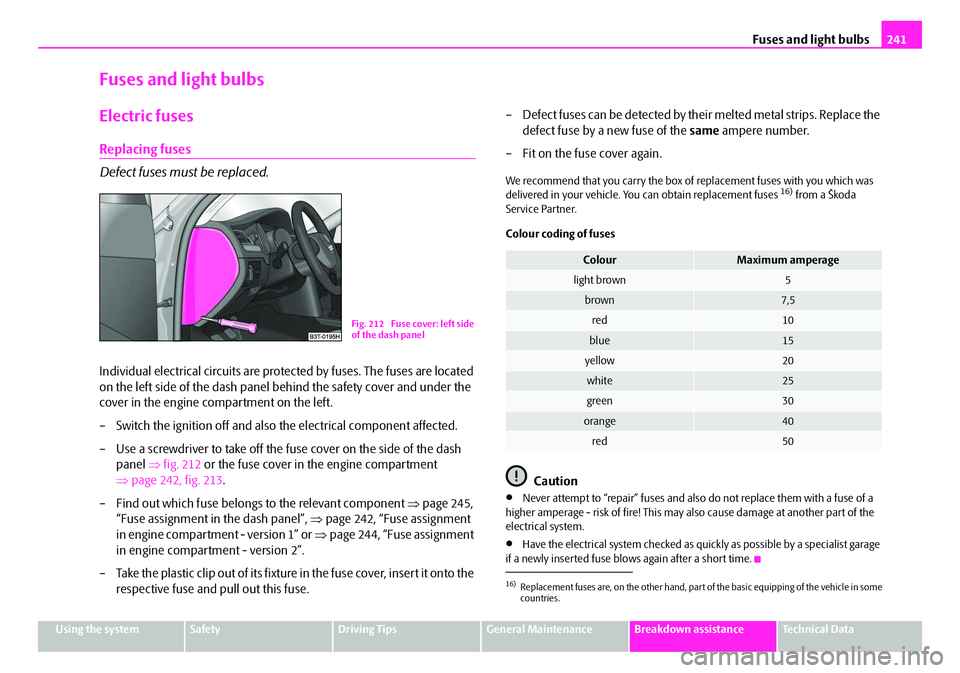
Fuses and light bulbs241
Using the systemSafetyDriving TipsGeneral MaintenanceBreakdown assistanceTechnical Data
Fuses and light bulbs
Electric fuses
Replacing fuses
Defect fuses must be replaced.
Individual electrical circuits are protected by fuses. The fuses are located
on the left side of the dash panel behind the safety cover and under the
cover in the engine compartment on the left.
– Switch the ignition off and also the electrical component affected.
– Use a screwdriver to take off the fuse cover on the side of the dash panel ⇒fig. 212 or the fuse cover in the engine compartment
⇒ page 242, fig. 213 .
– Find out which fuse belongs to the relevant component ⇒page 245,
“Fuse assignment in the dash panel”, ⇒page 242, “Fuse assignment
in engine compartment - version 1” or ⇒page 244, “Fuse assignment
in engine compartment - version 2”.
– Take the plastic clip out of its fixture in the fuse cover, insert it onto the respective fuse and pull out this fuse. – Defect fuses can be detected by their melted metal strips. Replace the
defect fuse by a new fuse of the same ampere number.
– Fit on the fuse cover again.
We recommend that you carry the box of replacement fuses with you which was
delivered in your vehicle. You can obtain replacement fuses 16) from a Škoda
Service Partner.
Colour coding of fuses
Caution
•Never attempt to “repair” fuses and also do not replace them with a fuse of a
higher amperage - risk of fire! This may also cause damage at another part of the
electrical system.
•Have the electrical system checked as quickly as possible by a specialist garage
if a newly inserted fuse blows again after a short time.
Fig. 212 Fuse cover: left side
of the dash panel
16)Replacement fuses are, on the other hand, part of the basic equipping of the vehicle in some
countries.
ColourMaximum amperage
light brown5
brown7,5
red10
blue15
yellow20
white25
green30
orange40
red50
NKO B6 20.book Page 241 Wednesday, March 26, 2008 3:15 PM
Page 258 of 272
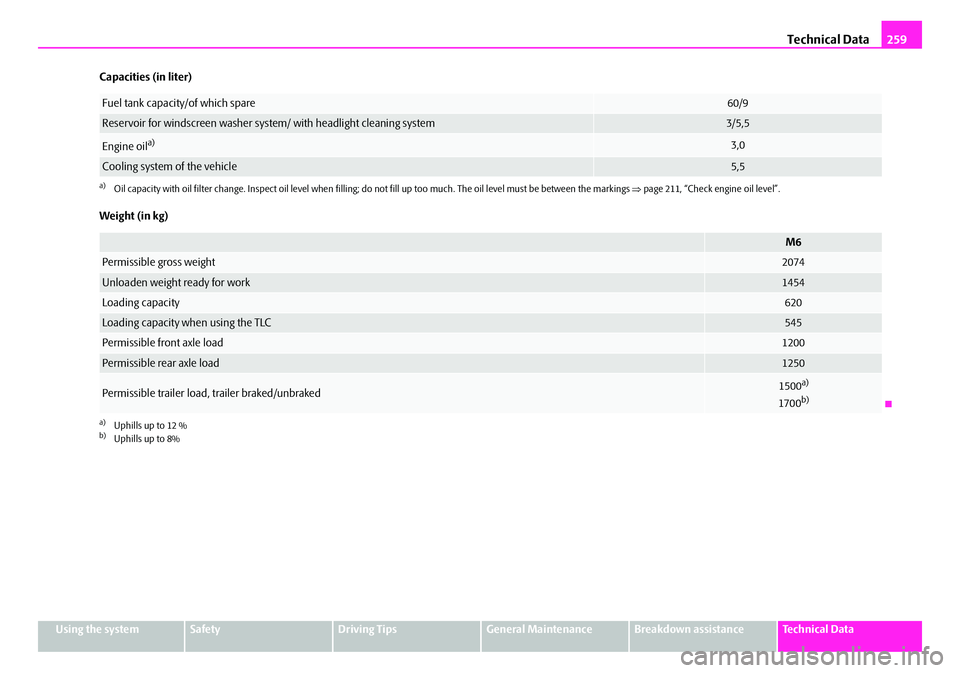
Technical Data259
Using the systemSafetyDriving TipsGeneral MaintenanceBreakdown assistanceTechnical Data
Capacities (in liter)
Weight (in kg)
Fuel tank capacity/of which spare60/9
Reservoir for windscreen washer system/ with headlight cleaning system3/5,5
Engine oila)
a)Oil capacity with oil filter change. Inspec
t oil level when filling; do not fill up too much. The oil level must be between the markings ⇒page 211, “Check engine oil level”.
3,0
Cooling system of the vehicle5,5
M6
Permissible gross weight2074
Unloaden weight ready for work1454
Loading capacity620
Loading capacity when using the TLC545
Permissible front axle load1200
Permissible rear axle load1250
Permissible trailer load, trailer braked/unbraked1500a)
1700b)
a)Uphills up to 12 %b)Uphills up to 8%
NKO B6 20.book Page 259 Wednesday, March 26, 2008 3:15 PM
Page 260 of 272
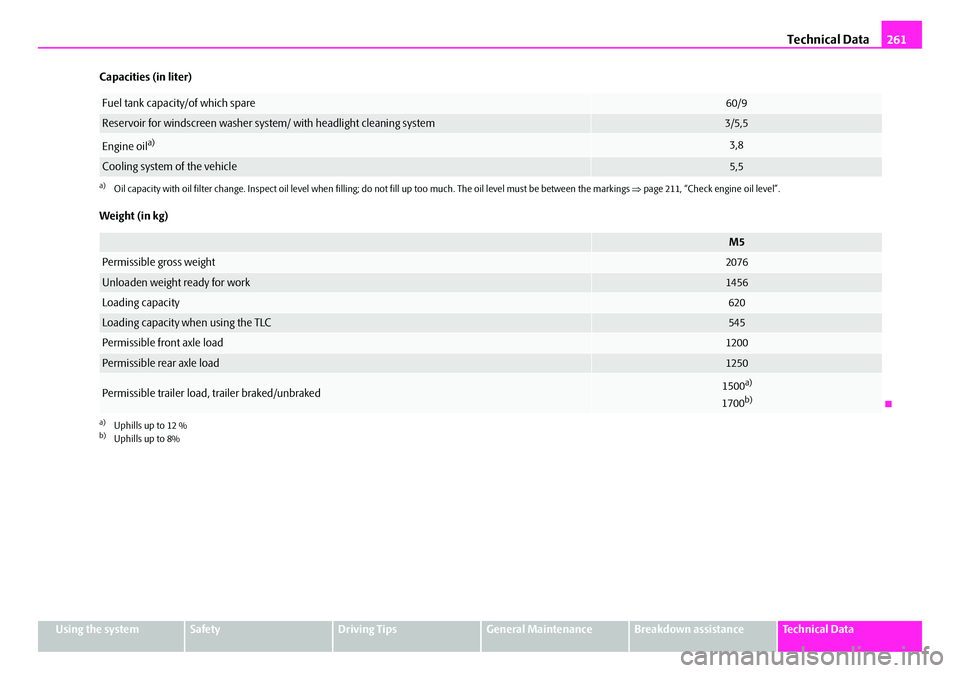
Technical Data261
Using the systemSafetyDriving TipsGeneral MaintenanceBreakdown assistanceTechnical Data
Capacities (in liter)
Weight (in kg)
Fuel tank capacity/of which spare60/9
Reservoir for windscreen washer system/ with headlight cleaning system3/5,5
Engine oila)
a)Oil capacity with oil filter change. Inspec
t oil level when filling; do not fill up too much. The oil level must be between the markings ⇒page 211, “Check engine oil level”.
3,8
Cooling system of the vehicle5,5
M5
Permissible gross weight2076
Unloaden weight ready for work1456
Loading capacity620
Loading capacity when using the TLC545
Permissible front axle load1200
Permissible rear axle load1250
Permissible trailer load, trailer braked/unbraked1500a)
1700b)
a)Uphills up to 12 %b)Uphills up to 8%
NKO B6 20.book Page 261 Wednesday, March 26, 2008 3:15 PM